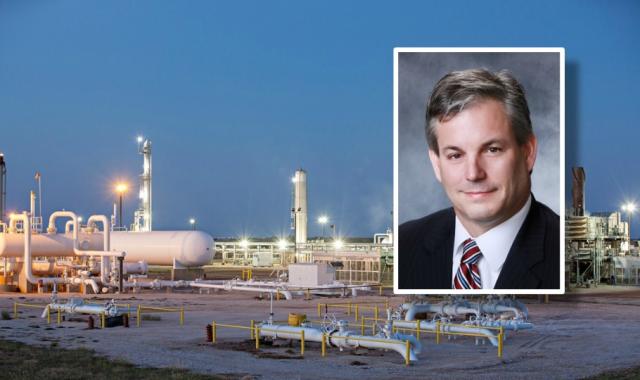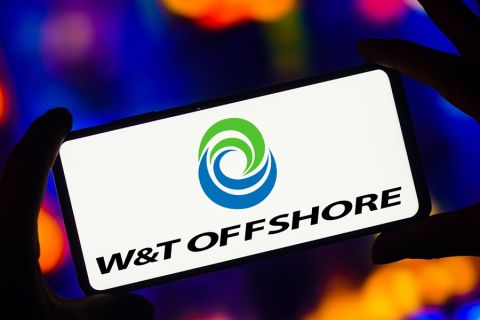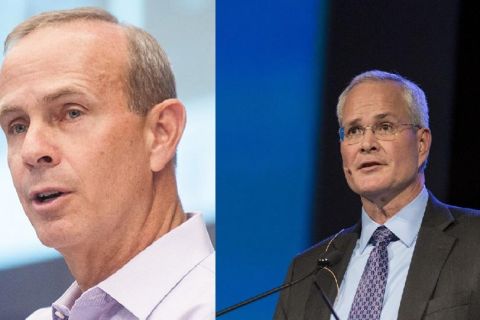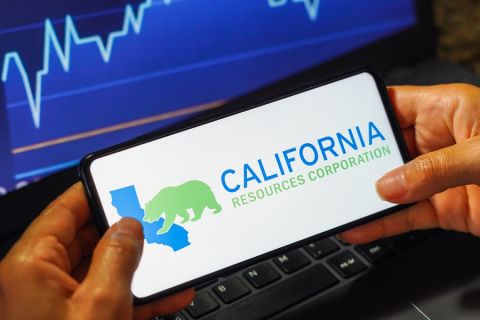
Inset: SemGroup Corp.'s CEO and president, Carlin Conner. SemGroup has a major presence in northern Oklahoma's Mississippi Lime play, anchored by its Rose Valley gas processing plant near Hopeton, Okla. In all, the firm has 365 million cubic feet of processing capacity in the region, served by 630 miles of gathering lines. Source: Semgroup Corp.
.SemGroup Corp. has been buffeted by the same headwinds to growth that challenged all of the energy sector for the past two years. So what has been its strategy? Execute expansion of its existing assets—as opposed to riskier M&A—preserve capital and make greater, and more efficient, use of existing assets, says its CEO. The approach—accompanied by a restructuring in 2016—has placed the firm, ranked No. 27 on the Midstream Business Midstream 50, in an ideal position for top financial performance now that the long-awaited turnaround may arrive this year, he adds.
MIDSTREAM You have had a long and diversified business career, what gives you the greatest personal satisfaction as a midstream executive?
CONNER You know, I really believe in the value of good leadership. I believe in setting the right tone at the top and creating the right culture. What I like to do, and what I’ve done at every company, is to create or embrace a collaborative culture, to create a culture of success: work hard, play hard, lots of community involvement, be very active. We want to be a company that people want to work for.
I think it’s a great measure of success for our employees when people talk with them on the weekends about where they work and they say, “I work at SemGroup.” The immediate feedback is positive. “Wow! Is there any chance you guys are hiring? Can you put a word in for me?” Those are the kinds of things I think our employees draw a lot of satisfaction from. Working for a desirable company can be very energizing. Creating that culture means that you have to be successful, that means you have to execute, you have to listen to your customers, you have to pay well, you have to be engaged with your host communities, and you have to live a safety culture—and you have to do all these things absolutely to enhance and create that culture.
I spent a lot of my career overseas with the Oiltanking Group, and the personal development and growth that I got to achieve by living overseas has been probably the most—for me, looking back—the most pleasing part of my career. I learned to appreciate all the different cultures in the world. We were active in Asia, Africa, former Soviet Union, as well as South America, Europe, North America and the Middle East. So I really was able to touch and experience almost every business culture out there. My family traveled a lot, and we learned a lot. You know, my kids are international kids due to that experience. So that, from a personal point of view, has been a real opportunity; we’ve been really fortunate to work overseas.
MIDSTREAM SemGroup completed a major corporate restructuring in the last year with the acquisition of your MLP, Rose Rock Midstream. What advantage does the restructuring give the organization?
CONNER The first and foremost advantage is simplifying the corporate structure. And with that comes an improved balance sheet and a lower cost of capital. That gives us a lot more financial flexibility to execute our strategy.
We liked having the MLP and understand the benefits of the structure. Acquiring Rose Rock was not something that we thought we would need to do, but market conditions warranted that action. Rose Rock’s high cost of capital, driven by the downturn in equity value, was untenable for growth at Rose Rock. The solid, undervalued, secure cash flows are now part of a larger, more financially sound corporate family.
And now that we’ve executed the acquisition without any shareholder lawsuits, which is rare for a controlled transaction like this, we have executed something that has made SemGroup a stronger company. But also for our Rose Rock unitholders, they were happy with the SemGroup share exchange they received for their ownership of Rose Rock.
MIDSTREAM What do you feel makes SemGroup more attractive to investors compared to other midstream operators?
CONNER That’s an interesting question. A lot of great companies out there do what we do in different basins and with different customers. I would tell you that I think investors—what they appreciate about SemGroup—is that we have a consistent, predictable management of the balance sheet, a very conservative management of the balance sheet. We prepared for “lower for longer,” and we’ve shown some resiliency through this commodity downturn. At the same time, we have invested heavily in organic growth in the business, which provides less risky growth for investors. When you combine the security and stability of how we manage the business and how we execute while developing projects around our footprint—and actually deliver a decent amount of growth—I think that’s a pretty strong combination for investors.
MIDSTREAM As you mentioned, SemGroup has focused on capturing growth opportunities and filling regional infrastructure gaps in and around its existing footprint. Is that strategy paying off for you?
CONNER Yes, the robust investment portfolio that we have, with all the organic growth that we have achieved and invested in, I think speaks to the fact that we have built off of our footprint and will continue to do so. We fill the needs of our customers throughout all of our areas where we operate, and I think that has been something that we have been really good at executing.
Now, we also wanted to grow our footprint, we wanted to reach other basins and do other things. A good example of where we were successful in finding something new was the Maurepas Pipeline, where we ventured into Southeast Louisiana and are building a three-pipe project for Motiva, two intermediate product pipes and one crude pipe. That project creates a new footprint for us, creates new customer relationships for us, and allows us to invest a half-billion dollars doing what we do best. That’s executing on these projects.
MIDSTREAM Maurepas is scheduled to enter service the first half of this year. Can you elaborate on what makes that project unusual or different compared to your other assets?
CONNER I believe the fact that Maurepas is refinery-facing provides a nice balance to our current upstream-facing businesses. It will give us some diversification to cash flows, where we’re not as dependent on commodity prices as we were before that project was achieved.
I think there are a couple of unique things about Maurepas. One is that two of the pipelines transport intermediate products and interconnect two refineries. Motiva announced a project a while back to take two refineries, its Convent and Norco refineries, and manage them as one, and optimize capital investments at each. That sounds like it’s a reasonable thing to do—but the plants are 35 miles apart. So we had to build these two lines that allow Motiva to optimize these two refineries. That’s driving significant benefits for Motiva and synergies going forward.
The third pipeline is a 24-inch crude line that is connecting the St. James, La., terminal to Norco, which is Motiva’s refinery right next to New Orleans. This is a classic crude oil project, which is not very different than anything else we’ve done. We build into a crude hub, from a production area to a demand center, and that’s what the project delivers.
The most unique thing about this project has to do with the 12-inch vacuum gasoil line, which is one of the intermediate lines that I referred to, and this is because the product has to be maintained at a heat of 140 degrees-plus or else it will solidify like a Tootsie Roll. So, we have a heated pipeline in the swamps of Louisiana that has pretty high technical components. It’s going to be a project that I think technical folks are going to be able to talk about for a long time. This is a pretty interesting project that uses technology and the best construction standards out there right now.
MIDSTREAM Producers in western Canada face challenges due to the region’s distance from major markets and opposition to new infrastructure. However, SemGroup has been expanding on its assets in this promising region. What do you see ahead for the oil and gas business in Alberta and British Columbia?
CONNER Prime Minister Trudeau came out recently and made a couple of announcements that were very supportive of the energy industry. I think it was welcomed by the industry because there was some concern that, under his leadership, there would be more regulation and more red tape—more costs—to try to develop oil and gas reserves in Canada. So first, it’s good to see the Canadian federal government recognize Alberta’s provincial desire to develop its energy reserves for the benefit of Canada.
Of course, we’re in the middle of that. Currently—we have a pretty significant footprint, we have gas gathering, processing and transportation—I think the fact that we’re there already, we’re permitted, we have capacity, and we have executed in Canada, gives us a great leg up, a great advantage, as we try to grab other business in the area. We have announced that we are going to build a 200 million-[cubic feet]-a-day plant in the Montney, up in the Grand Prairie [Alberta] area.
The fact that there is this micro market for condensate in Fort McMurray is really exciting because that helps take the pressure off of having to have a natural gas price that is much greater than maybe what is there today. The liquids will carry development from the economics point of view for the producers.
MIDSTREAM There has been an ongoing problem with the Montney and Duvernay; they can’t compete on price with gas produced elsewhere in North America.
CONNER Correct, let me give you my sales speech on what’s exciting to us about the Montney and what we are doing there. First and foremost from a production point of view, it has more to do with the condensate, the liquids-rich production that is coming out of the Montney and Duvernay. That condensate is being sold into Fort McMurray to be used as diluent for oil sands development. The oil sands demand today—I’m not trying to forecast out what the future looks like—is much greater than local supply. There is a huge gap in supply and demand that needs to be plugged by Gulf Coast-originated condensate, which as you can appreciate comes at quite a bit of a transportation premium.
With these condensate economics and extensive condensate plays that are being discovered and produced, we will start to see gas prices being less relevant to the overall final investment decisions for these producers.

MIDSTREAM SemGroup has international operations outside its core, North American region, in Mexico and Great Britain. How do these businesses fit into your growth plans?
CONNER Mexico and the U.K. I would consider noncore, but they are still very productive businesses for us. They generate positive earnings that we enjoy. We’re very focused in North America, more so in the Midcontinent, Canada and the Gulf Coast, than in Mexico, but we’re also looking at energy reform projects in Mexico, and we’re excited about the potential. The Mexican business that we have today is our asphalt business, but we are very interested in midstream growth internally in Mexico.
MIDSTREAM How does SemGroup plan to survive—or thrive—in the lower-for-longer commodity price environment?
CONNER Going into a downcycle, you have to be prepared from a balance sheet point of view. You have to have a conservative view going into the cycle so that you can weather the cycle. We had that, and so we’re enjoying the protection of being able to withstand some pressure on earnings. That is not putting us in any danger with respect to the balance sheet.
The other thing is to find projects that you can build that are low-multiple projects off your footprint and that possibly require fewer customer commitments. That’s because customers are very leery of committing in these kinds of markets. So if you can find ways to grow your business and feel comfortable with the commercial approach that your team is taking, then I think you can do some things in these markets that others can’t do. That’s how we’re executing. Good examples of what we’re doing are in Canada and in the Midcontinent, just building off of what’s already there and taking advantage of market conditions.
MIDSTREAM SemGroup has always maintained a strong community relations program for its Tulsa, Okla., headquarters and its other locations. How does this emphasis fit into your corporate culture?
CONNER I just think it is very important to remember that we are a guest in all the communities where we operate, and we want to make sure that these communities appreciate who we are and what kind of company we are—and that we care. That comes from how we run our business and how we do things, to be sure that we’re following all the rules and regulations—if not exceeding those rules and regulations—making sure that we’re protecting the environment and protecting any stakeholders.
Also, we are helping those communities where they may need something. And whether that’s educational support or municipal support—parks and community centers for example—we want to be involved in satisfying the objectives that those communities have. It’s not just writing checks. It’s also getting our employees engaged so that we become a bit more personal in those markets.

MIDSTREAM Do you have any predictions on what lies ahead for the midstream in 2017?
CONNER I think we will see some consolidations. I think there are probably too many companies out there so there will be some pressure to achieve the growth rate that some of the investment community would like to see. I think you have to see some costs run out of the system, which consolidation can allow. Commercial synergies can be gained through that as well.
I also think we are going to see more activism—what we see with Dakota Access Pipeline—become more of a political statement. We are going have more protests. To me, it underscores why we have to be a good operator. The industry needs to do the right thing. We need to invest properly and make sure that every system we build is engineered properly, and we’re thoughtful about where we build, how we build and how we operate. I think we need to be aware of these communities that invite us in. This ties back to my point about being a guest.
I would summarize by saying SemGroup is a company that has a very interesting footprint and that is very focused on growing that footprint. When I think about 2017, I think we’re going to have another robust year with solid growth capex. We will have a few exciting projects. We have, I think, outsized opportunities that are probably not reflected in our stock price. We should—if we execute properly—be one of the higher-performing equities in 2017.
Paul Hart can be reached at pdhart@hartenergy.com or 713-260-6427.

Recommended Reading
W&T Offshore Adds John D. Buchanan to Board
2024-04-12 - W&T Offshore’s appointment of John D. Buchanan brings the number of company directors to six.
Exxon, Chevron Tapping Permian for Output Growth in ‘24
2024-02-02 - Exxon Mobil and Chevron plan to tap West Texas and New Mexico for oil and gas production growth in 2024, the U.S. majors reported in their latest earnings.
California Resources Corp. Nominates Christian Kendall to Board of Directors
2024-03-21 - California Resources Corp. has nominated Christian Kendall, former president and CEO of Denbury, to serve on its board.
Petrie Partners: A Small Wonder
2024-02-01 - Petrie Partners may not be the biggest or flashiest investment bank on the block, but after over two decades, its executives have been around the block more than most.
CEO: Coterra ‘Deeply Curious’ on M&A Amid E&P Consolidation Wave
2024-02-26 - Coterra Energy has yet to get in on the large-scale M&A wave sweeping across the Lower 48—but CEO Tom Jorden said Coterra is keeping an eye on acquisition opportunities.





